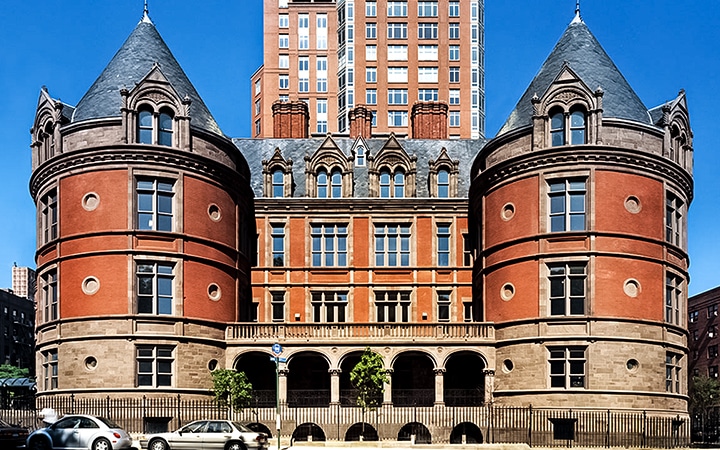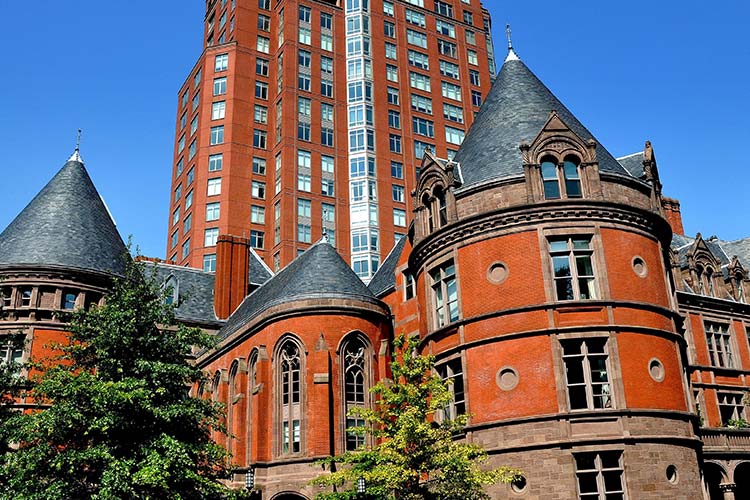Ask a New Yorker for directions to the New York Cancer Hospital in the Upper West Side and you’ll likely be met with a blank stare. It has been decades since it was a functioning hospital, but the New York Cancer Hospital building—now home to super-luxury condominiums—is one of the great architectural treasures of New York City.
The building, meant to suggest a chateau in the Loire Valley of France, was built in 1887 as the first cancer hospital in the city. Its round turrets, five in all, were designed to deter germs from accumulating in corners, a primary principle of good hygiene at the time. An air shaft ran up the center of each tower in order to prevent air from stagnating in the wards, which represented cutting-edge ventilation thinking at the time.
The building had its ebbs and flows, however. In the 1950s, operations for the cancer hospital moved to the East Side of Manhattan, where it eventually expanded and became Memorial Sloan Kettering Cancer Center. The building was briefly repurposed as a nursing home. However, due a Medicaid fraud scandal, the nursing home was closed in 1974. In 1976, the Landmarks Preservation Commission designated the building a landmark, condemning it to death by decrepitude.
By the 1980s locals referred to it as “the castle.” Stray cats abounded, slinking through the weeds and garbage strewn about. Next door, the Castle Hotel ran a brisk trade in prostitution and crack-cocaine.
Things began turning around in the mid 80s. Around that time, an architectural firm called RKTB began working on refurbishing the building. The plan to renovate and repurpose the building spanned over 20 years and four owners, but RKTB was the one constant.
“The thing about this building,” said Peter Bafitis, AIA, who was the principal in charge of the project for its duration, “is that it is a traditional masonry building. It was all built by hand.” While this method may produce high-quality work, Bafitis went on, “by the 1980s the building was nearly 100 years old. It had had 100 years to deflect.” In other words, the building had shifted, leaned, stretched and all other sorts of things that buildings do when they’re not properly cared for over the years.

Another major challenge, as Bafitis explained, was the very emblematic roof: “The roof system was volumetrically complicated due to the pinnacle roofs, which had to be taken down in their entirety, because they were framed with wood, and the wood was completely rotted. There was no way of rebuilding it in place.” Bafitis continued: “The roof had to be catalogued very, very precisely, so that it could go back with new material, in exactly the same configuration as the old.”
RKTB, along with the owners, was committed to restoring the building to its original state as much as possible, so they chose to use real slate instead of a composite facsimile on the roof, and to specify mahogany wood windows, which was much more expensive than using a modern metal. The firm lobbied for such fidelity to the original, and the developer thankfully agreed. “And all along,” Bafitis recounted, “the Landmarks Preservation Commission was scrutinizing the renovation quite closely.” Anybody who has worked on a landmarked building knows that the pressure is intense and the responsibility great.
It is worth noting that this all stands in stark contrast to the interior. All the floors, framing and masonry walls from the original structure were demolished, with RKTB instead thinking creatively about how best to go about such a radical repurposing—from medical to luxury residential.
Today, 455 Central Park West stands as one of the most recognizable and unique apartment complexes on the Upper West Side of Manhattan. There are, to be sure, more expensive addresses, but perhaps none conveys the same combination of class, historical significance and architectural sophistication as the New York Cancer Hospital. And if you’re looking for a modest pied-a-terre in Manhattan, look no further. There’s a unit for sale.











